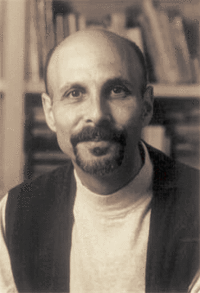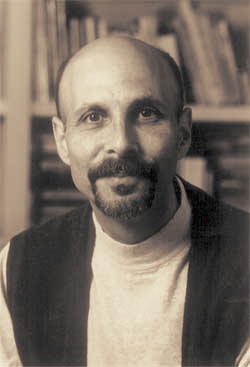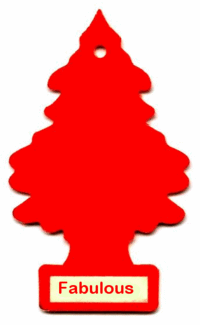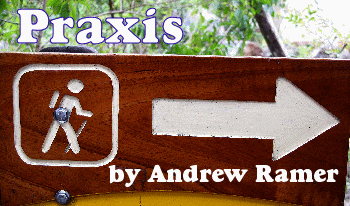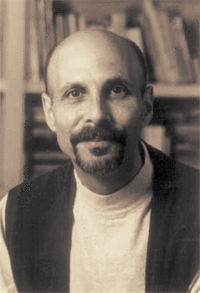 Community Trust
Community Trust
Andrew Ramer
What does it mean to be held in community, held and nurtured and encouraged to grow? That was something I yearned for, as a misfit boy few of the other kids wanted to play with, who ended up most afternoons by himself in the rhododendron grove in our large backyard. When I was seven or eight I started having a dream that recurred for years. It’s night and I’m watching a group of men dancing together around a fire in a clearing in the woods, while I stand alone behind a tree, afraid to join them. While the waking me longed to be part of a community, every group I tried to join rejected me, offended me, or fell apart. Even my attempts to fit into the gay world failed. I don’t like opera, never saw a Bette Davis movie, flunked Cruising 101 and Bathhouse Etiquette. And then in the summer of 1990, I received a short letter in the mail that changed my life. The writer, Raven Wolfdancer, wrote from Atlanta to tell me that he’d read a copy of my book Two Flutes Playing and found it moving. That letter led to more letters, phone calls, and then Raven invited me to speak at the first Gay Spirit Visions Conference, of which he was one of the founders.
In those days I was living in Brooklyn, had never spent time in the South, and never spoken at a conference, let alone as a keynote. How could I ever be a presenter, especially with Harry Hay and Atlanta poet and therapist Franklin Abbott? I was terrified to go but a voice inside me said “Yes” to Raven’s invitation to spend three days in the mountains of North Carolina with 75 gay men. It never occurred to me that all these years later I would be the only person to have attended every subsequent annual gathering – because it’s my spiritual home, the community that has fed me, raised me, shaped, molded, held, challenged, and blessed me, for more than eighteen years.
Raven, Peter Kendrick, Ron Lambe and the other men who organized that first conference welcomed me into a Southern gay and faerie core community whose roots went back more than a decade. As a New York Jew I found something unexpectedly familiar about the South and its outsider tradition, a kind of American cultural queerness that I identify with and have grown to love. True, the deep and painful divisions in Southern culture trouble and grieve me, but they are part of my extended family’s history. And when people say that they are spiritual but not religious, I understand, although I consider myself both. Congregation Sha’ar Zahav in San Francisco is my religious home, but GSV is my spiritual home. I’ve met some of my dearest friends there, men I rely on to keep my tent pegged to the rocky soil of a wobbly planet and a windy existence.
After that first conference Raven and I began to collaborate on a book about the sacred role of gay men in the world, his art inspiring my words, which evoked further images from his rich imagination. After he was murdered I assembled what we’d done into a desktop version, knowing that Stories of Our People would remain both the unripened fruit of our friendship, and none the less a deep expression of my life in the loving family of GSV.
What I know about community I learned from our faerie/pagan/Native American- influenced rituals, our heart circles, and from small group discussions and long walks in the woods with friends. As a recluse by nature, with a dark teal gregarious streak, GSV taught me the truth of John Donne’s words: “No man is an island, entire of itself.” Oh, and there was the year when Hurricane Ivan struck and we were up all night baling water, building sandbag walls, watching cabin roofs fly off, all the while in mourning for the recent death of one of our beloved members. Then two days later we were called upon to support the community who run the conference center we meet at, as they mourned the death of the family of one of their staff members, who were killed in the storm.
What I know about eldering I learned at GSV, from rambling conversations with Harry Hay that began at the first conference, from our other presenters, and from nearly two decades of exchanges with the devoted men who sustain the gathering year after year. We’ve grown from 75 men to 140 each Fall, adding Winter and Spring gatherings – not without struggle, pain, despair, fear, rejection, conflict, and the constant presence of loss and grief. Men have come and gone, gone and sometimes returned. Why do I go back year after year? That’s easy. When I first arrived at Little Scaly Mountain and was wrapped up in the Southern warmth of GSV, I felt that I had finally come out from behind that tree and joined the circle of men my recurring dream had foretold, and I’ve felt that way ever since.
What I know about decision making I learned from being involved in a community run by consensus, a slow and marvelous process that unfailingly creates a perfect conference every year, even its warts hairy and witch-perfect. Into this non-hierarchical space we have welcomed keynote speakers including Harry Hay, James Broughton, Malcolm Boyd, Mark Thompson, Tom Spanbauer, Will Roscoe, Don Clark, Christian de la Huerta, and Toby Johnson, to name a few. Our speaker this fall will be Clyde Hall. Not bad for a gathering of queers in the mountains of North Carolina.
The mountain we meet on is also home to a lush communities of rhododendrons, to which I always retreat for some time of meditation, comforting me as they did when I was small. And we also share that mountain with a family of ancient dwarf oaks, the descendants of survivors from the last Ice Age, whose glaciers slowly advanced from the north but stopped just before they reached Little Scaly. I’ve learned so much from that community of trees, which seeded the East Coast woodlands after the last of the ice receded, and it’s those wise ancient oaks who are the inspiration for this issue’s praxis.
Take a blank 8 ½ by 11 sheet of what we used to call typing paper, that’s now called copy paper or printer paper. On this blank sheet draw the outline of a tree with a nice broad trunk and roots and branches spreading out above and below, mirroring each other.
This tree is a map of your communities, now, in the past, and stretching out toward the future. Start by going down to the roots of your tree and writing in along them the names of the communities, good and bad, nurturing and stifling, that you belonged to in the past: family, religious groups, schools, glee club, drama club, track team, summer camps, out crowd, etc. On the edge of the roots write in the names of the groups you didn’t belong to but longed to be a part of. And beyond those groups, near the bottom of the page, write in the names of the groups you didn’t belong to and didn’t want to belong to.
Now move up to the trunk of your tree and write in, right in the center: ME. Sometimes we think of ourselves as individuals, but as Whitman said, “I am a large, I contain multitudes,” so I invite you to include the community of yourself/yourselves, as part of your tree. Above and below yourself write in the names of the communities you are most intimately connected with, family, friends, spiritual/political/educational groups you belong to, your coworkers, all the communities you are involved with on a daily basis. These can be cyber communities, and please keep in mind that your communities may not just be people. Pets, flocks, herds, parks, gardens, nature spirits, disembodied friends and angels also belong on the list of your most intimate communities.
Next go up to your tree’s branches, and write in the names of communities you are less involved in, that you connect with from time to time. The people from the annual yoga retreat you see once a year. Your dentist, doctor and the people in their offices, the people in the salon where you get your hair done, and the workers in your favorite health food store, belong on this list. And don’t forget the family around the corner who you run into at the park three or four times a year, whose names you don’t even know but who you always enjoy seeing, watching their kids grow. And your never-married Aunt Minnie, who you visit every few years, the one who tells you the truth about your family that you parents never would.
At the very tips of your tree’s branches, on different limbs, write in: the names of communities and groups you want to belong to, groups you don’t know how to get into, and groups you suspect wouldn’t want you that you still feel drawn to. People with homes in three different locations, close friends of your favorite celebrity, enlightened beings who have burned away all of their karma. Out beyond the branches, near the edge of the page, write the names of communities you don’t belong to and don’t want to belong to. Born again Wiccans, Bio-diesel fundamentalists, unrepentant Republicans, people who eat steak, may all be on your list.
When you are done, draw a line right inside the very edges of the entire page. This rectangular box represents All of Life on Earth. It includes the communities you belong to and the ones you don’t belong to. It includes all the groups you don’t ever want to belong to, that wouldn’t want you anyway, all of which we are still connected to, and must learn to live with, for we share the same small orbiting sphere and the same destiny – to live together, or die together.
This tree is a portrait of the communities of your life. It may take you several days or longer to create it. I spent over a week working on mine. I kept remembering communities I’d belonged to. That meditation group in the early 80s, those friends I used to go bird watching with, the food coop I went to with my first boyfriend in Berkeley, that class for post bar mitzvah nerds our rabbi taught in his study.
Tape your tree up over your night table, on your refrigerator door, on the wall across from your toilet. Put it somewhere where you can meditate upon it, feel your way into it, and see and sense how this tree of yours is connected to the trees of everyone else in the world, including everyone who’s done this bit of praxis – because hopefully somewhere on your tree, on a branch if not on the trunk, you have written: “The White Crane community.”
Fold your tree up and put it in your wallet. Slip it in your desk drawer at work and sneak looks at it during the day, when you’re supposed to be doing something else. Ask yourself how this tree appears to you. Is it bottom or top heavy? Is your trunk bare or filled with loved ones? How would you like this tree to look? What would you like to see upon it? If there isn’t a GSV in your life, consider joining us. And if GSV doesn’t sound like something you’d enjoy – four days in the Southern woods with men in leather and tee shirts and skirts, sharing a moldy old cabin with a view of the mountains that will feed your living breathing soul – then ponder this question – “What is my cup of carrot-celery-beet juice?” And if you’re not drinking from it, not even sipping from it – do something every day to seek out a community or communities that will feed your thirst, so that in a year’s time you can draw a new tree, one that mirrors back to you your connection to others who hold you and nurture you and encourage you to grow.
Raven Wolfdancer was an artist, gardener, teacher, and spiritual visionary, featured in the Fall 2008 issue of RFD magazine, our cousin publication, grounded too in Southern faerie culture.
For more information about the Gay Spirit Visions Conference, please visit their website:
www.gayspiritvisions.org, or write to GSV at PO Box 339, Decatur GA 30031-0339.
This is just an excerpt from this issue of White Crane. We are a reader-supported journaland need you to subscribe to keep this conversation going. So to read more from this wonderful issue SUBSCRIBE to White Crane. Thanks!
Andrew Ramer is a writer and educator. He is the author of numerous books including Revelations for a New Millenium, Little Pictures: Fiction for a New Age and the Gay classic Two Flutes Playing: A Spiritual Journeybook for Gay Men from White Crane Books.
Ramer lives in San Francisco. Praxis is a regular feature of White Crane.
 Animal, Vegetable, Mineral
Animal, Vegetable, Mineral Community Trust
Community Trust
